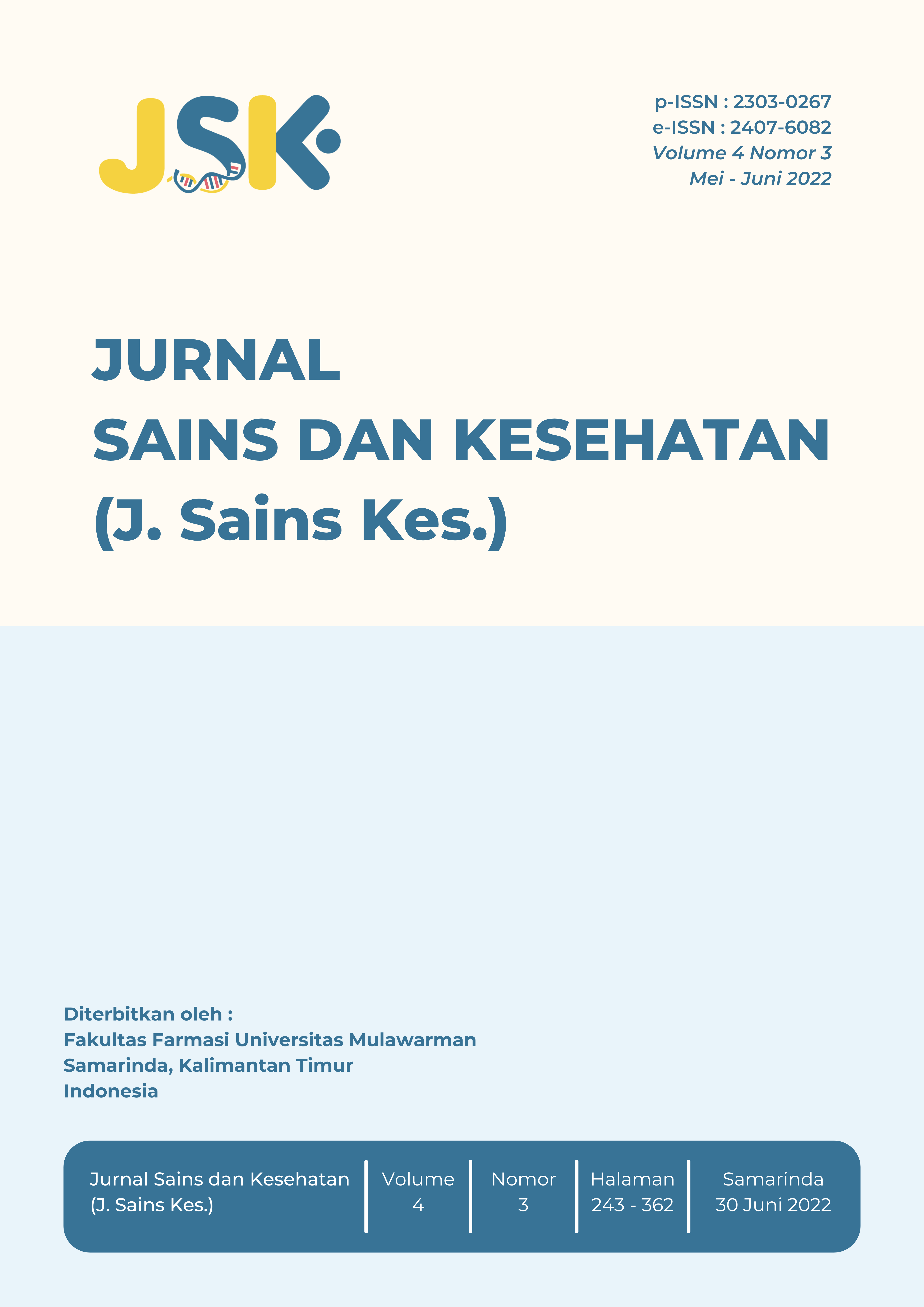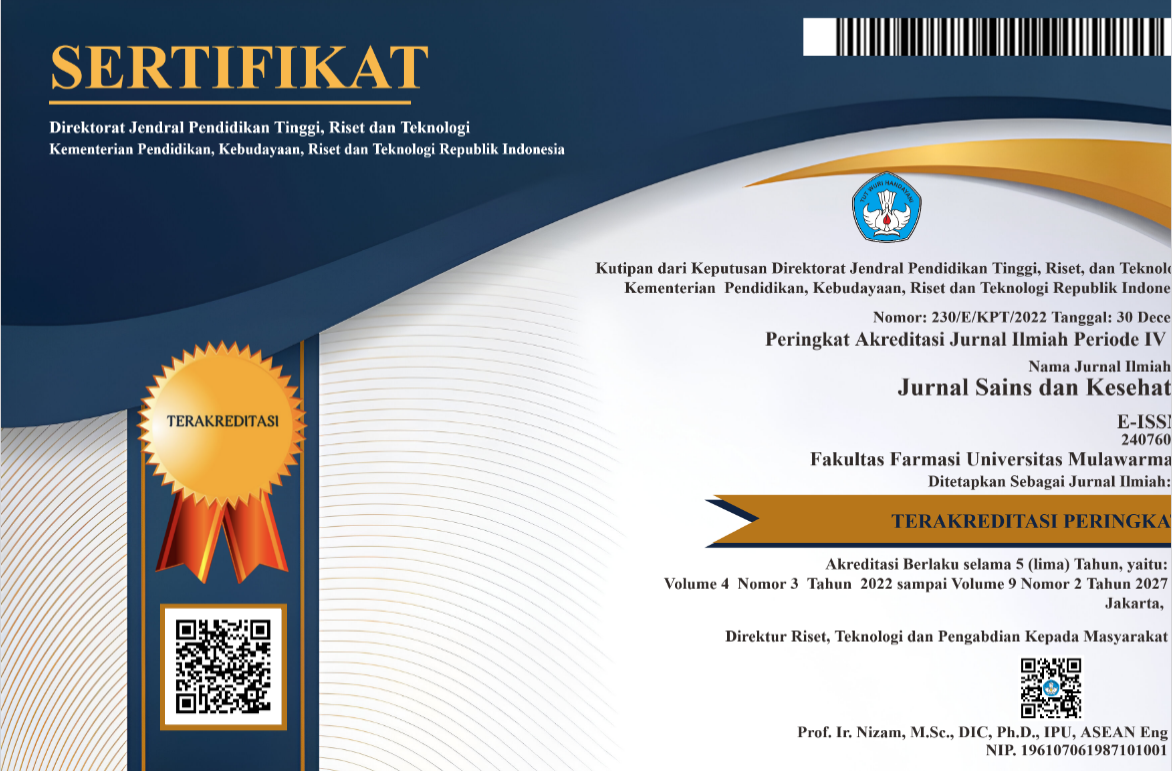Efektivitas Deferasirox pada Pasien Thalasemia Mayor: Artikel Review
Efficacy of Deferasirox for Thalassemia Mayor: Review Article
DOI:
https://doi.org/10.30872/jsk.v4i3.580Keywords:
Thalassemia, Deferasirox, EfficacyAbstract
References
H. Bajwa and H. Basit, “Thalassemia,” Brenner’s Encycl. Genet. Second Ed., pp. 60–62, Nov. 2021, doi: 10.1016/B978-0-12-374984-0.01534-5.
H. Sawitri and C. A. Husna, “Karakteristik Pasien Thalasemia Mayor Di Blud Rsu Cut Meutia Aceh Utara Tahun 2018,” AVERROUS J. Kedokt. dan Kesehat. Malikussaleh, vol. 4, no. 2, p. 62, 2018, doi: 10.29103/averrous.v4i2.1038.
L. De Franceschi et al., “Oxidative stress and ? -thalassemic erythroid cells behind the molecular defect,” Oxid. Med. Cell. Longev., 2013, doi: 10.1155/2013/985210.
M. A. Yesilipek et al., “A Phase II, Multicenter, Single-Arm Study to Evaluate the Safety and Efficacy of Deferasirox after Hematopoietic Stem Cell Transplantation in Children with ?-Thalassemia Major,” Biol. Blood Marrow Transplant., vol. 24, no. 3, pp. 613–618, Mar. 2018, doi: 10.1016/J.BBMT.2017.11.006.
A. Ansari-Moghaddam, H. A. Adineh, I. Zareban, M. Mohammadi, and M. Maghsoodlu, “The survival rate of patients with beta-thalassemia major and intermedia and its trends in recent years in Iran,” Epidemiol. Health, vol. 40, p. e2018048, 2018, doi: 10.4178/EPIH.E2018048.
M. J. Cunningham, E. A. Macklin, E. J. Neufeld, and A. R. Cohen, “Complications of ?-thalassemia major in North America,” Blood, vol. 104, no. 1, pp. 34–39, Jul. 2004, doi: 10.1182/BLOOD-2003-09-3167.
M. R. Alipour, Z. Pezeshkpour, S. M. Namayandeh, and M. Sarebanhassanabadi, “Evaluation of ECG and echocardiographic findings in patients aged 2 to 18 years affected with thalassemia major,” Prog. Pediatr. Cardiol., vol. 63, p. 101454, Dec. 2021, doi: 10.1016/J.PPEDCARD.2021.101454.
S. Susanah et al., “Time to Start Delivering Iron Chelation Therapy in Newly Diagnosed Severe ? -Thalassemia,” Biomed Res. Int., vol. 2020, 2020, doi: 10.1155/2020/8185016.
C. Takpradit et al., “Using of deferasirox and deferoxamine in refractory iron overload thalassemia,” Pediatr. Int., vol. 63, no. 4, pp. 404–409, Apr. 2021, doi: 10.1111/PED.14444.
O. E. Orisakwe, C. N. Amadi, and C. Frazzoli, “Management of Iron Overload in Resource Poor Nations: A Systematic Review of Phlebotomy and Natural Chelators,” J. Toxicol., vol. 2020, 2020, doi: 10.1155/2020/4084538.
C. Borgna-Pignatti and M. Marsella, “Iron Chelation in Thalassemia Major,” Clin. Ther., vol. 37, no. 12, pp. 2866–2877, Dec. 2015, doi: 10.1016/J.CLINTHERA.2015.10.001.
Y. Aydinok et al., “Effects of deferasirox-deferoxamine on myocardial and liver iron in patients with severe transfusional iron overload,” Blood, vol. 125, no. 25, pp. 3868–3877, Jun. 2015, doi: 10.1182/BLOOD-2014-07-586677.
J. C. Wood et al., “The effect of deferasirox on cardiac iron in thalassemia major: impact of total body iron stores,” Blood, vol. 116, no. 4, pp. 537–543, Jul. 2010, doi: 10.1182/BLOOD-2009-11-250308.
D. J. Pennell et al., “A Multicenter, Randomized, Open-Label Trial Evaluating Deferasirox Compared with Deferoxamine for the Removal of Cardiac Iron in Patients with ?-Thalassemia Major and Iron Overload (CORDELIA).,” Blood, vol. 120, no. 21, p. 2124, Nov. 2012, doi: 10.1182/BLOOD.V120.21.2124.2124.
Y.-R. Lai et al., “Efficacy and Safety of Deferasirox in Chinese Patients with Non-Transfusion-Dependent Thalassemia: 1-Year Results from the Thetis Study,” Blood, vol. 126, no. 23, pp. 4570–4570, Dec. 2015, doi: 10.1182/BLOOD.V126.23.4570.4570.
A. T. Taher et al., “Deferasirox reduces iron overload significantly in nontransfusion-dependent thalassemia: 1-year results from a prospective, randomized, double-blind, placebo-controlled study,” Blood, vol. 120, no. 5, pp. 970–977, Aug. 2012, doi: 10.1182/BLOOD-2012-02-412692.
A. J. Marengo-Rowe, “The thalassemias and related disorders,” Proc. (Bayl. Univ. Med. Cent)., vol. 20, no. 1, p. 27, Jan. 2007, doi: 10.1080/08998280.2007.11928230.
“IRON OVERLOAD AND CHELATION - Guidelines for the Management of Transfusion Dependent Thalassaemia (TDT) - NCBI Bookshelf.” https://www.ncbi.nlm.nih.gov/books/NBK269373/ (accessed Mar. 26, 2022).
H. Dou, Y. Qin, G. Chen, and Y. Zhao, “Effectiveness and Safety of Deferasirox in Thalassemia with Iron Overload: A Meta-Analysis,” Acta Haematol., vol. 141, no. 1, pp. 32–42, Jan. 2019, doi: 10.1159/000494487.
M. Puliyel et al., “Ferritin trends do not predict changes in total body iron in patients with transfusional iron overload,” Am. J. Hematol., vol. 89, no. 4, pp. 391–394, 2014, doi: 10.1002/AJH.23650.
Downloads
Published
Issue
Section
How to Cite
Similar Articles
- Hurria Maulana Ali, Annisa Muhyi, Yudanti Riastiti, Hubungan Usia, Kadar Hemoglobin Pretransfusi dan Lama Sakit terhadap Kualitas Hidup Anak Talasemia di Samarinda , Jurnal Sains dan Kesehatan: Vol. 3 No. 4 (2021): J. Sains Kes.
- Aila Johanna, Clemarie Natasha Tholib, Christina Jeanny Soekiono, Nicholas Hardi, Surilena Surilena, Pengaruh Pelatihan Manajemen Pasien dengan Kondisi Gaduh Gelisah terhadap Self-Efficacy Staf Medis dan Non Medis RS Atma Jaya , Jurnal Sains dan Kesehatan: Vol. 6 No. 2 (2025)
- Danang Ardiyanto, Tofan Aries Mana, Kadar Testosteron Darah Pasien Setelah Pemberian Jamu Aprodisiaka Di Rumah Riset Jamu“Hortus Medicus” Tawangmangu , Jurnal Sains dan Kesehatan: Vol. 1 No. 5 (2016): J. Sains Kes.
- Amelia Lorensia, Ananda Yudiarso, Nurul Safina, Persepsi Apoteker terhadap Hambatan dalam Pelayanan Kefarmasian Penyakit Asma Di Apotek , Jurnal Sains dan Kesehatan: Vol. 2 No. 4 (2020): J. Sains Kes.
- Ni Made Suastini, Fauna Herawati, Efikasi dan Keamanan dari Pancreatic Enzyme Replacement Therapy pada Pasien Cystic Fibrosis : Sebuah Kajian Sistematis , Jurnal Sains dan Kesehatan: Vol. 3 No. 4 (2021): J. Sains Kes.
- Raden Retno Ariani, Lia Amalia, Suryani Gunadharma, Kusnandar Anggadiredja, Studi Efikasi dan Pemantauan Reaksi Obat Merugikan dari Antiplatelet pada Pasien Pasca Stroke Iskemik di RSUP dr. Hasan Sadikin Bandung , Jurnal Sains dan Kesehatan: Vol. 5 No. 5 (2023): J. Sains Kes.
- Asrianto Asrianto, Suarna Samai, Muhamad Sahidin, Indra Taufik Sahli, Risda Hartati, Wiwiek Mulyani, Efikasi Biolarvasida Berbagai Tanaman Untuk Pengendalian Vektor Nyamuk Anopheles , Jurnal Sains dan Kesehatan: Vol. 5 No. 2 (2023): J. Sains Kes.
You may also start an advanced similarity search for this article.




